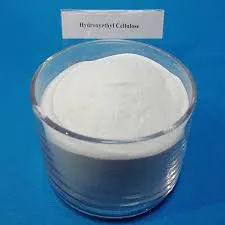
Nov . 11, 2024 19:42 Back to list
hydroxypropyl methyl cellulose
Hydroxypropyl Methyl Cellulose An Overview of Its Properties and Applications
Hydroxypropyl methyl cellulose (HPMC) is a non-ionic, cellulose-based polymer that has garnered extensive attention in various industries, including pharmaceuticals, food, cosmetics, and construction materials. As a derivative of cellulose, HPMC is produced through the chemical modification of cellulose fibers, making it a versatile and widely used compound.
Chemical Structure and Properties
HPMC is characterized by the replacement of hydroxyl groups in cellulose with hydroxypropyl and methyl groups. This substitution alters the physical and chemical properties of cellulose, enhancing its solubility in water and enabling it to form gels and films. HPMC is often available in various viscosity grades, which affects its thickening and film-forming abilities.
One of the standout properties of HPMC is its ability to form a pseudo-plastic gel upon gelatinization, which enhances its utility in various applications. The polymer's thermal stability, biodegradability, and compatibility with other compounds make it an attractive option for formulators.
Applications in Pharmaceuticals
In the pharmaceutical industry, HPMC is commonly utilized as a binder, thickening agent, and controlled-release agent in tablet formulations. Its ability to modify drug release profiles allows for the development of extended-release medications, improving patient compliance by reducing the frequency of dosing. HPMC is also used in ophthalmic preparations and as a lubricant in various dosage forms due to its low toxicity and favorable rheological properties.
HPMC's role as a coating agent for tablets is particularly notable. It creates a smooth, protective layer that enhances the appearance of tablets while providing a barrier against moisture, which can degrade sensitive active ingredients. This coating also facilitates swallowing and can mask unpleasant tastes, further improving the patient experience.
hydroxypropyl methyl cellulose

Food Industry Applications
In the food sector, HPMC serves as a thickening and stabilizing agent in a wide variety of products, ranging from sauces and dressings to dairy products and baked goods. It improves the texture and mouthfeel of food products while extending their shelf life. HPMC's potential as a fat replacer in low-calorie food formulations has also gained traction, as it can mimic the texture and viscosity traditionally provided by fats, making it an appealing choice for health-conscious consumers.
Cosmetics and Personal Care
The cosmetics industry utilizes HPMC for its film-forming capabilities and its ability to improve the texture of creams, lotions, and gels. It acts as a stabilizer in emulsions and provides a soothing feel on the skin. Additionally, due to its non-irritating nature, HPMC is often included in formulations for sensitive skin or in products designed for infants.
Construction and Building Materials
In construction, HPMC is valued for its water-retention properties and workability. It is commonly used in tile adhesives, plasters, and joint compounds, where it enhances adhesion, improves the spreadability of materials, and slows down the drying process. By allowing more time for application, HPMC contributes to better workmanship.
Conclusion
Hydroxypropyl methyl cellulose is a multifaceted polymer that plays a crucial role across various industries. Its unique properties make it an invaluable ingredient in pharmaceuticals, food production, cosmetics, and construction. As manufacturers continue to explore innovative applications and formulations, the significance of HPMC is likely to expand, further solidifying its position as a cornerstone in modern material science. As demand for versatile and effective ingredients grows, HPMC stands out as a sustainable and reliable choice for formulators seeking to enhance product performance and consumer satisfaction.
-
Versatile Hpmc Uses in Different Industries
NewsJun.19,2025
-
Redispersible Powder's Role in Enhancing Durability of Construction Products
NewsJun.19,2025
-
Hydroxyethyl Cellulose Applications Driving Green Industrial Processes
NewsJun.19,2025
-
Exploring Different Redispersible Polymer Powder
NewsJun.19,2025
-
Choosing the Right Mortar Bonding Agent
NewsJun.19,2025
-
Applications and Significance of China Hpmc in Modern Industries
NewsJun.19,2025







